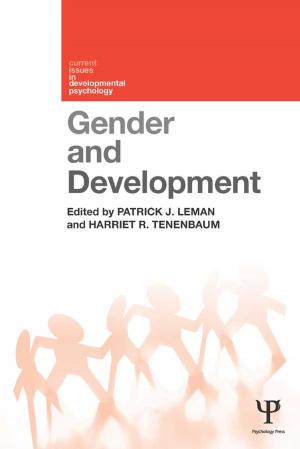Launching a Successful Research Program at a Teaching University
Nonfiction, Health & Well Being, Psychology, Research, Reference & Language, Education & Teaching, Social & Cultural Studies, Social Science| Author: | Robert S. Ryan, Avidan Milevsky | ISBN: | 9781315516554 |
| Publisher: | Taylor and Francis | Publication: | September 13, 2016 |
| Imprint: | Routledge | Language: | English |
| Author: | Robert S. Ryan, Avidan Milevsky |
| ISBN: | 9781315516554 |
| Publisher: | Taylor and Francis |
| Publication: | September 13, 2016 |
| Imprint: | Routledge |
| Language: | English |
This practical guide addresses the challenges for building and maintaining a college research program in an environment that does not focus on supporting research activity and for those with a heavy teaching load. The challenges faced by teacher-researchers and solutions to issues are reviewed. The steps for maximizing research productivity are outlined: time management, obtaining research space and equipment and funding, recruiting and managing human subjects, and overcoming bureaucratic stumbling blocks. Chapters feature opening vignettes, examples, cases, figures, tables, summaries, suggested readings, and research references which provide a scientific grounding.
Highlights include coverage of:
-The latest time saving digital resources including automatic literature search alerts, Zotero for managing literature, Dropbox for sharing files, Open Science for managing workflow, and OpenSesame and OpenStax Tutor.
-Strategies for recruiting subjects such as flyers and posting lab meeting minutes on a web page.
- How to increase research productivity while still engaging in effective teaching.
-The problems of the availability of human subjects and strategies for recruiting from classes, offering extra credit for research participation, and participation as a course requirement.
- Using students as volunteer research assistants and strategies for recruiting and managing volunteers along with ethical considerations.
-Bureaucratic stumbling blocks and strategies for overcoming those challenges.
- How to use browser/word processor add-ons that store and organize literature in a searchable library and produce citations and reference lists.
-The use of free open source software to design experiments and collect data and free cloud based resources to store electronic research files.
The steps for maximizing research productivity are outlined in chapter 1: time management, obtaining research space and equipment and funding, recruiting and managing human subjects, and overcoming bureaucratic stumbling blocks, along with impediments and solutions for establishing a research program.Strategies to overcome time constraints including automatic literature searches, Zotero for managing your literature, Dropbox for sharing files, and the Open Science Framework for managing workflow are provided in Chapter 2. Chapter 3 provides tips on obtaining funding. Chapters 4 and 5 provide strategies for recruiting and managing research participants such as ad hoc recruiting from classes, offering extra credit for research participation, and participation as a course requirement. The book concludes with a review of other items to consider when developing a research program.
Intended for professional development or teacher training courses offered in masters and doctoral programs in colleges and universities or as a supplement in graduate level research methods courses, this book is also an invaluable resource for faculty development centers and university administrators. Designed for both early career and veteran teacher-researchers looking to enhance their research productivity, this book appeals to college teachers of all levels and disciplines.
This practical guide addresses the challenges for building and maintaining a college research program in an environment that does not focus on supporting research activity and for those with a heavy teaching load. The challenges faced by teacher-researchers and solutions to issues are reviewed. The steps for maximizing research productivity are outlined: time management, obtaining research space and equipment and funding, recruiting and managing human subjects, and overcoming bureaucratic stumbling blocks. Chapters feature opening vignettes, examples, cases, figures, tables, summaries, suggested readings, and research references which provide a scientific grounding.
Highlights include coverage of:
-The latest time saving digital resources including automatic literature search alerts, Zotero for managing literature, Dropbox for sharing files, Open Science for managing workflow, and OpenSesame and OpenStax Tutor.
-Strategies for recruiting subjects such as flyers and posting lab meeting minutes on a web page.
- How to increase research productivity while still engaging in effective teaching.
-The problems of the availability of human subjects and strategies for recruiting from classes, offering extra credit for research participation, and participation as a course requirement.
- Using students as volunteer research assistants and strategies for recruiting and managing volunteers along with ethical considerations.
-Bureaucratic stumbling blocks and strategies for overcoming those challenges.
- How to use browser/word processor add-ons that store and organize literature in a searchable library and produce citations and reference lists.
-The use of free open source software to design experiments and collect data and free cloud based resources to store electronic research files.
The steps for maximizing research productivity are outlined in chapter 1: time management, obtaining research space and equipment and funding, recruiting and managing human subjects, and overcoming bureaucratic stumbling blocks, along with impediments and solutions for establishing a research program.Strategies to overcome time constraints including automatic literature searches, Zotero for managing your literature, Dropbox for sharing files, and the Open Science Framework for managing workflow are provided in Chapter 2. Chapter 3 provides tips on obtaining funding. Chapters 4 and 5 provide strategies for recruiting and managing research participants such as ad hoc recruiting from classes, offering extra credit for research participation, and participation as a course requirement. The book concludes with a review of other items to consider when developing a research program.
Intended for professional development or teacher training courses offered in masters and doctoral programs in colleges and universities or as a supplement in graduate level research methods courses, this book is also an invaluable resource for faculty development centers and university administrators. Designed for both early career and veteran teacher-researchers looking to enhance their research productivity, this book appeals to college teachers of all levels and disciplines.















